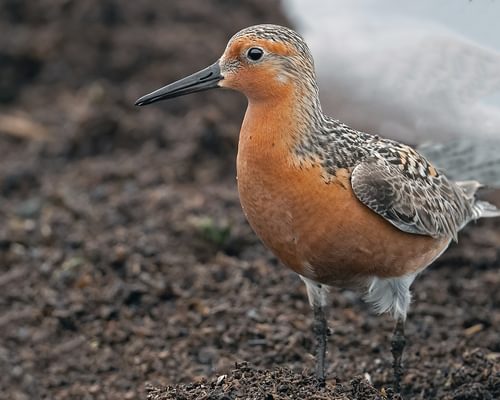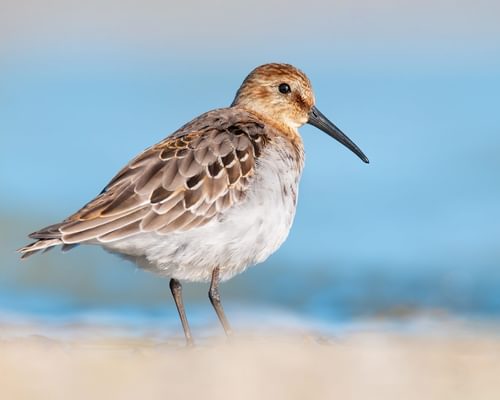Curlew Sandpiper
Near ThreatenedCalidris ferruginea
Visual Identification
Appearance
The Curlew Sandpiper is a small wader with a distinctive down-curved bill. In breeding plumage, it displays a rich chestnut-red head, neck, and underparts, with dark-spotted upperparts. Non-breeding adults are predominantly grey above and white below.
Juveniles have scaly-patterned upperparts with buff edges and a peachy wash on the breast. The species exhibits a slightly larger and longer, more curved bill than other small sandpipers.
Size
Length
18cm to 23cm
Wingspan
38cm to 41cm
Weight
45g to 90g
Colours
Males and females have similar plumage
Primary Colour
Red Grey White
Secondary Colour
Brown
Beak Colour
Black
Leg Colour
Black
Habitat and Distribution
Habitats
Woodland
Garden
Wetland
Coastal
Urban
Farmland
Grassland
Desert
Tundra
Rainforest
Mountain
Savanna
Distribution
Curlew Sandpipers breed in the high Arctic tundra of Siberia. During non-breeding seasons, they are found along coastal areas across a vast range, including Africa, southern Asia, and Australasia.
In Australia, they are common summer visitors to coastal areas. They prefer intertidal mudflats, estuaries, and salt marshes but they can also be found inland wetlands during migration.
Elevation Range
Sea level to 4,500 meters
Climate zones
Arctic, Temperate, Tropical
Distribution Map
This map gives you a rough idea of where you might spot a Curlew Sandpiper. The coloured areas show countries where these birds have been seen.
A few things to keep in mind:
- Birds might not be everywhere in the coloured areas, for example, they may be present around the coast of that country
- Where birds live can change with seasons and available food
- This map is quite simple - it doesn't show exact locations
We're working on making our maps even better! Soon, we hope to show you:
- More detailed maps for bigger countries, including state and region
- How birds move around during different seasons
Distribution by Region
Behaviour and Ecology
Bird Attributes
This feature is in beta. We'd love your feedback to improve it!
Share your thoughtsBird Attributes Explained
Our bird attributes system rates various aspects of a bird's capabilities on a scale of 0-100, based on data from field observations, scientific studies, and expert knowledge.
Attribute Categories:
- Agility: Manoeuvrability, speed, and grace in flight or movement.
- Strength: Physical power, often correlating with size and hunting abilities.
- Adaptability: Ability to thrive in various environments or changing conditions.
- Aggressiveness: Territorial behaviour and assertiveness, particularly during breeding seasons.
- Endurance: Stamina, often seen in migration patterns or foraging behaviours.
Understanding the Ratings:
- 0-20: Very Low
- 21-40: Low
- 41-60: Average
- 61-80: High
- 81-100: Very High
Remember, these attributes are relative to other bird species and don't necessarily indicate superiority.
Hover over the icon next to each attribute for more information.
Tap the icon next to each attribute for more information.
Agility
Reflects the bird's manoeuvrability, speed, and grace in flight or movement.
The Curlew Sandpiper demonstrates remarkable agility, moving quickly across mudflats and performing rapid feeding motions. Their ability to navigate diverse habitats from Arctic tundra to coastal mudflats, coupled with their swift, non-stop long-distance flights, indicates high agility.
Strength
Indicates the bird's physical power, often correlating with size and hunting abilities.
Whilst not particularly strong for their size, Curlew Sandpipers possess adequate strength to undertake gruelling long-distance migrations, including crossing the Himalayas at high altitudes. Their ability to probe deeply into mud also suggests moderate strength.
Adaptability
Represents the bird's ability to thrive in various environments or changing conditions.
Curlew Sandpipers show exceptional adaptability, thriving in diverse environments from Arctic breeding grounds to tropical wintering areas. Their ability to utilise various coastal and inland wetland habitats, coupled with their successful long-distance migration strategy, demonstrates high adaptability.
Aggressiveness
Measures the bird's territorial behaviour and assertiveness, particularly during breeding seasons.
Generally non-aggressive, Curlew Sandpipers often forage in mixed flocks with other waders. They don't exhibit particularly territorial behaviour outside of the breeding season. However, males do perform aerial displays during breeding, suggesting some level of competitive behaviour.
Endurance
Reflects the bird's stamina, often seen in migration patterns or foraging behaviours.
Curlew Sandpipers display remarkable endurance, capable of flying non-stop for up to 5,000 kilometres during migration. Their ability to cross vast distances, including high-altitude Himalayan passages, coupled with their longevity (up to 19 years for some individuals) indicates exceptional endurance for their size.
Diet
Curlew Sandpipers primarily feed on small invertebrates, including insects, molluscs, and crustaceans. They use their long, curved bills to probe deep into mud and sand, often feeding in shallow water. During the breeding season, they may also consume plant material.
Behaviour
Curlew Sandpipers are often seen probing the mud with their long, curved bills in a sewing machine-like motion. They typically forage in small flocks, moving quickly across mudflats. They may form large, dense flocks during migration, particularly at staging sites.
Vocalisation
The Curlew Sandpiper's call is a soft, rolling 'chirrup' or 'chirrip', often given in flight. During the breeding season, males produce a trilling song described as a rapid 'trit-trit-trit-treeee', typically delivered during display flights over their territories.
Nesting & Breeding
Curlew Sandpipers form breeding pairs soon after arriving in the Arctic tundra, typically in June. Males perform aerial displays to attract females.
Nests are simple scrapes on the ground, often near water and lined with leaves and lichen. Females typically lay 4 eggs, which are pale green to olive with brown spots.
Incubation lasts about 21 days, primarily by the female. Chicks are precocial and can feed themselves shortly after hatching, fledging after about 14-16 days.
Lifespan
years
The Curlew Sandpiper typically lives for 10 to 15 years.
Like all birds, lifespan can be affected by factors including predation, habitat quality, disease, and access to food sources.
Conservation and Status
Global Conservation Status
Due to population declines, the Curlew Sandpiper is listed as Near Threatened. Key threats include habitat loss in breeding and non-breeding areas, particularly the destruction of tidal mudflats. Climate change impacts on Arctic breeding grounds are also a concern.
Birdwatching Tips
- Look for Curlew Sandpipers on coastal mudflats and salt marshes during migration
- Observe the distinctive down-curved bill and longer legs compared to other small sandpipers
- Watch for their rapid feeding behaviour, often in mixed flocks with other waders
- In Australia, check coastal areas during the austral summer for non-breeding birds
Additional Information
Quick Facts
Other names:
Curlew Stint
Family:
ScolopacidaePredators
Main predators include Arctic foxes, skuas, and gulls on breeding grounds. During migration and winter, various birds of prey and larger gulls pose threats.
Did You Know?
- Curlew Sandpipers can fly non-stop for up to 5,000 kilometres during migration.
- They have been recorded at elevations up to 4,500 meters while crossing the Himalayas.
- Some individuals live up to 19 years despite their small size.
Was this bird profile helpful?
Your feedback helps us improve our content
Thanks for your feedback!
Your input helps us improve our content.
Community Experience
Community Ratings
No ratings yet - be the first to rate this bird!
Latest Community Reviews
No reviews yet
Sign in to be the first to review
Community Reviews
Create Your Free Account Welcome Back!
Join our community to rate birds and share your experiences. Creating an account is completely free and only takes a minute. Sign in to your account to rate birds and share your experiences with our community.
Your information is secure and will never be shared.
By creating an account, you agree to our Privacy Policy.
Similar Birds
References
- 1
website: BirdLife International. 2017. Calidris ferruginea (amended version of 2016 assessment). The IUCN Red List of Threatened Species 2017: e.T22693431A110631069.
View source - 2 3
report, 2015: Taylor in litt.

